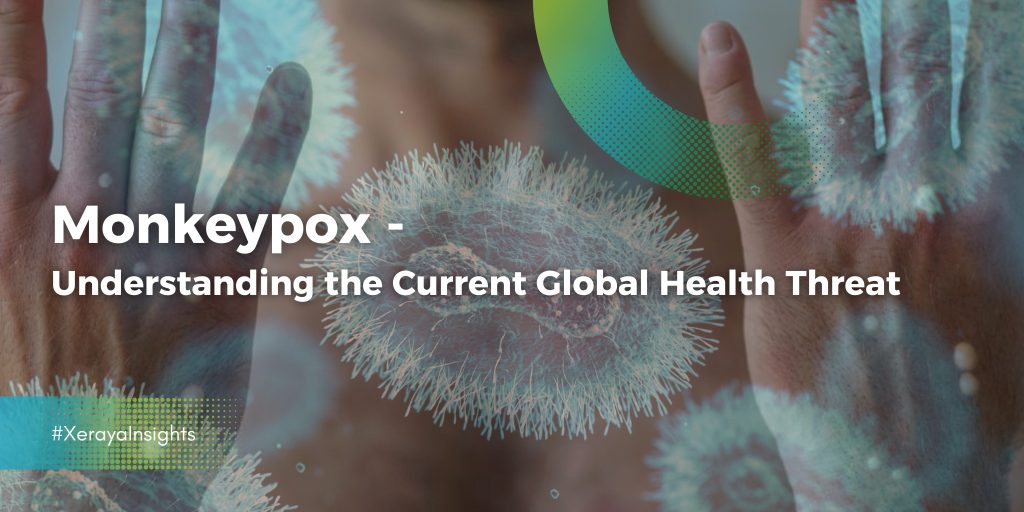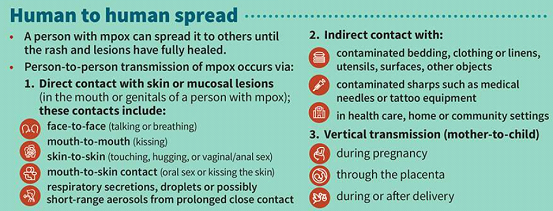
With a total of 103 048 laboratory confirmed cases in 121 countries as of 31 July 2024, and the recent announcement on 14 August 2024 by World Health Organization (WHO) Director General that monkeypox (mpox) constitutes as a public health emergency of international concern (PHEIC), we take a look at this virus to try and understand it better with the information that is available. Furthermore, this is the second time WHO declared mpox as a PHEIC, the first time was in 2022. We will explore the nature of the disease, it’s transmission, symptoms and prevention strategies.
September 2024
First of all, mpox is caused by the monkeypox virus (MPXV), which is an enveloped double-stranded DNA (dsDNA) virus of the Orthopoxvirus genus, which also includes the variola virus (smallpox), cowpox virus, and vaccinia virus. Since it’s in the same family of smallpox, hence this is why the vaccine used for mpox is similar to those used in smallpox, as we will discuss later. MPXV was first discovered in a monkey research facility in Denmark in 1958. The first human case (a nine-month old baby) was identified in the Democratic Republic of Congo in 1970. There are two distinct clades of the virus, Clade I (subclade Ia and Ib) and Clade II (subclades IIa and IIb). As reported by WHO, the cases of mpox increased significantly last year, and the number of cases this year so far (in August), has exceeded the number of cases last year with more than 15 600 cases and 537 deaths.
But what is even more worrying is the emergence of a new clade (Clade 1b) of mpox that is rapidly spreading in Africa, especially in Congo and it’s surrounding neighbors. According to WHO committee chair, Prof Dimie Ogoina, another worrying is that the spread of a new sexually transmissible strain of mpox is something that will affect the entire globe, not just Africa.
How does the virus spread?
WHO reported that monkeypox is transmitted via human-to-human contact mainly through sex or close contact with respiratory secretions, skin lesions of an infected person, or recently contaminated objects. While it is less contagious than smallpox, the transmission can occur through droplets during prolonged face-to-face contact or through direct contact with bodily fluids or lesion material. So far, there are no evidence of it spreading via airborne.

Source: WHO
The person infected with mpox can transmit the disease on to others until all the sores have healed and a new layer of skin has been formed.
Common symptoms
The incubation period of mpox ranges from 5-21 days. The common symptoms of mpox according to WHO are:
⦁ The characteristic skin rash or mucosal lesions
⦁ Can range from a few to thousands,
⦁ Affects the face, palms of hands, soles of the feet, groin, genital and/or anal regions
⦁ Mucosal lesions are found in the mouth, throat, anus, rectum or the genitals.
⦁ Rectal pain is a common feature as well
⦁ Lasting two to four weeks
⦁ Fever – usually occurs within 1-3 days of mpox
⦁ Swollen lymph nodes
⦁ Headache
⦁ Muscle aches
⦁ Back pain
⦁ Sore throat
⦁ Low energy
It’s also important to distinguish mpox from other illnesses such as chickenpox, measles, bacterial skin infections, scabies, syphilis and medication-associated allergies. Please consult your doctor to clarify if you have any of these symptoms.
Diagnostics
The golden standard for the detection of the MPXV is done via Polymerase Chain Reaction (PCR) which is a technique that was commonly used during the COVID-19 pandemic, with samples of the virus’s DNA is taken from the skin lesions. Although a lot of countries have increased their capabilities of conducting PCR diagnostics, Africa still lacks enough testing facilities to consistently detect the spread of the MPXV.
To counter this, on the 29 August 2024, WHO asked manufacturers of mpox in vitro diagnostics (IVDs) to submit their expression of interest for Emergency Use Listing (EUL) which will be useful in a low-income setting but still needs to be effective. Since 2022, WHO has delivered around 150 000 test kits globally and expected another 30 000 kits to be delivered to Africa in the coming weeks. This will help to monitor the severity of the spread, especially the new Clade 1b.
Vaccines
People who were born before 1980’s would have probably received the smallpox vaccine and it is thought that these group of people will have some cross-protection againts mpox as well as they are both from the same genus.
WHO has also triggered the process of Emergency Use Listing for mpox vaccines which allows countries without their own national regulatory approval to use the vaccines, and enables Gavi and UNICEF to procure the vaccines for distributions. According to the CDC (US) and NHS (UK), it is recommended for you to get the vaccine if you are sexually active, especially those who are gay, bisexual or have sex with other men.
Generally there are two types of vaccines used for mpox:-
⦁ JYNNEOS is a vaccine manufactured by Bavarian Nordic (BN). It is a modified vaccinia Ankara strain (MVA-BN) that contains virus that has been altered which it could not multiply in the human body. It is a 2 doses vaccine with 28 days apart between doses. The effectiveness of JNNEOS against mpox ranges from 66-89% after two doses. This is currently the preferred vaccine by WHO, CDC and few other countries. JYNNEOS generated sales of about USD730 million in 2023, a three-fold increase from 2022, and it is expected to see a much higher increase in 2024.
⦁ ACAM2000 is a vaccine manufactured by Emergent BioSolutions. It is a live-attenuated smallpox vaccine that has been shown to be effective against mpox. This vaccine is derived from the New York City Board of Health strain of vaccinia and ACAM2000 is a second-generation smallpox vaccine that is derived from Dryvax. However, CDC reports that this vaccine has more side effects and contraindications than JYNNEOS.
BioNTech is developing their mRNA-based vaccine, BNT166, in partnership with the Coalition for Epidemic Preparedness Innovations (CEPI) and is currently in Phase I/II trial. Moderna is also developing their mRNA-based vaccine for mpox, mRNA-1769 which is also currently running a Phase I/II trial. Recently, they published their animal studies which show promising results in monkeys. Both BioNTech and Moderna’s Phase I/II trial is due mid-2025.
Prevention and Treatment
Prevention strategies include avoiding contact with animals that could harbor the virus, especially in regions where monkeypox is endemic. Health workers should implement standard infection control practices when caring for patients. Vaccination against smallpox has been shown to be about 85% effective in preventing monkeypox.
Tecovirimat (TPOXX) is an anti-viral drug to treat mainly smallpox but will also work on monkeypox and cowpox. It works by interfering with a protein called VP37 that is found on the surface of the virus, and prevents the virus from replicating normally hence slowing down the infection.
Global and Regional Outlook
The global spread of monkeypox has highlighted the need for a coordinated international response to emerging infectious diseases. WHO has been working closely with countries, including Malaysia, to strengthen surveillance, laboratory capacity, and preparedness to manage potential outbreaks. According to the CDC, the Clade II MPXV that is responsible for the 2022-2023 outbreak had a mortality rate of about 0.1%, however, the recent clade Ib has a reported mortality rate of approximately 2-3%. This has raised concerns in multiple countries, and some has taken procedures to increase their border controls.
In Southeast Asia, the increasing number of cases has prompted countries to enhance their public health responses. Regional cooperation and information sharing will be critical in controlling the spread of monkeypox in non-endemic countries.
⦁ On 2nd September 2024, the Malaysian Minister of Health announced that the country will receive the Tecovirimat antiviral drug and MVA-BN vaccine through the COVID-19 ASEAN Response Fund. These are not intended for public use yet, only to the healthcare workers and to those who are vulnerable.
⦁ On 29 August 2024, it was reported that Indonesia has also made an order for 4,450 doses of mpox vaccine from Denmark at a price tag of Rp3.5 million or USD227 per dose.
⦁ To date, Singapore Ministry of Health has given approval to MVA-BN on 27 August 2024 for their adult population, and vaccination is offered to healthcare workers and those who are considered high-risk.
⦁ Thailand announced a budget of 21 million baht to purchase 3,000 doses of the mpox vaccine.
Monkeypox remains a significant public health concern, particularly with it’s recent spread to non-endemic regions, including Southeast Asia. Continued vigilance, public education, and international cooperation will be key in preventing and controlling monkeypox outbreaks. The statistics presented underscore the importance of ongoing monitoring and preparedness in the region. As the situation evolves, timely updates and adherence to public health guidelines will be essential to safeguard public health. By staying informed and taking necessary precautions, the public can help mitigate the risk of monkeypox transmission and ensure a rapid response to any emerging cases.
Reference
⦁ https://www.who.int/news-room/fact-sheets/detail/mpox
⦁ https://worldhealthorg.shinyapps.io/mpx_global/
⦁ https://www.cdc.gov/poxvirus/mpox/index.html
⦁ https://www.ema.europa.eu/en/human-regulatory-overview/public-health-threats/mpox
⦁ https://www.moh.gov.my/




